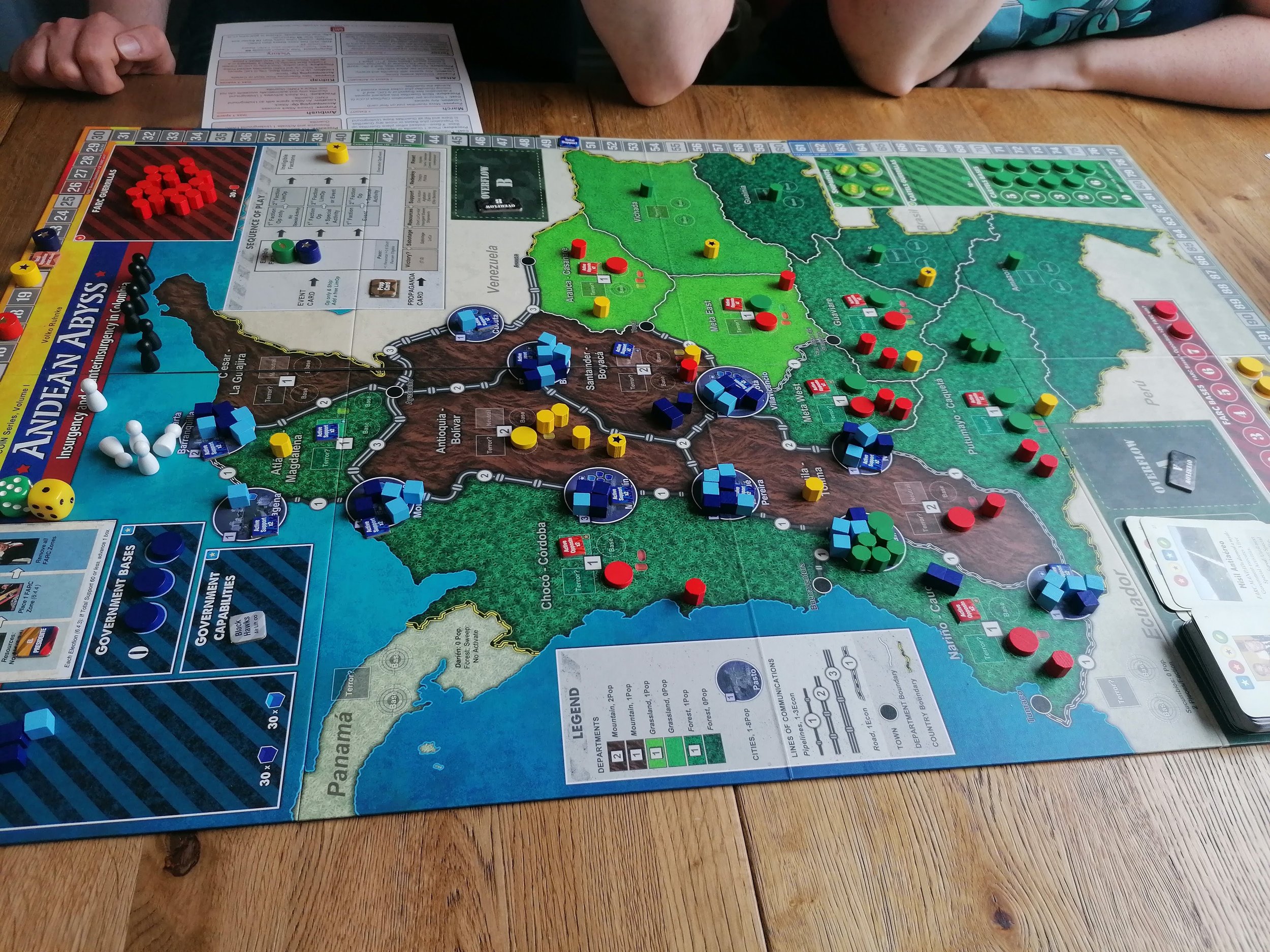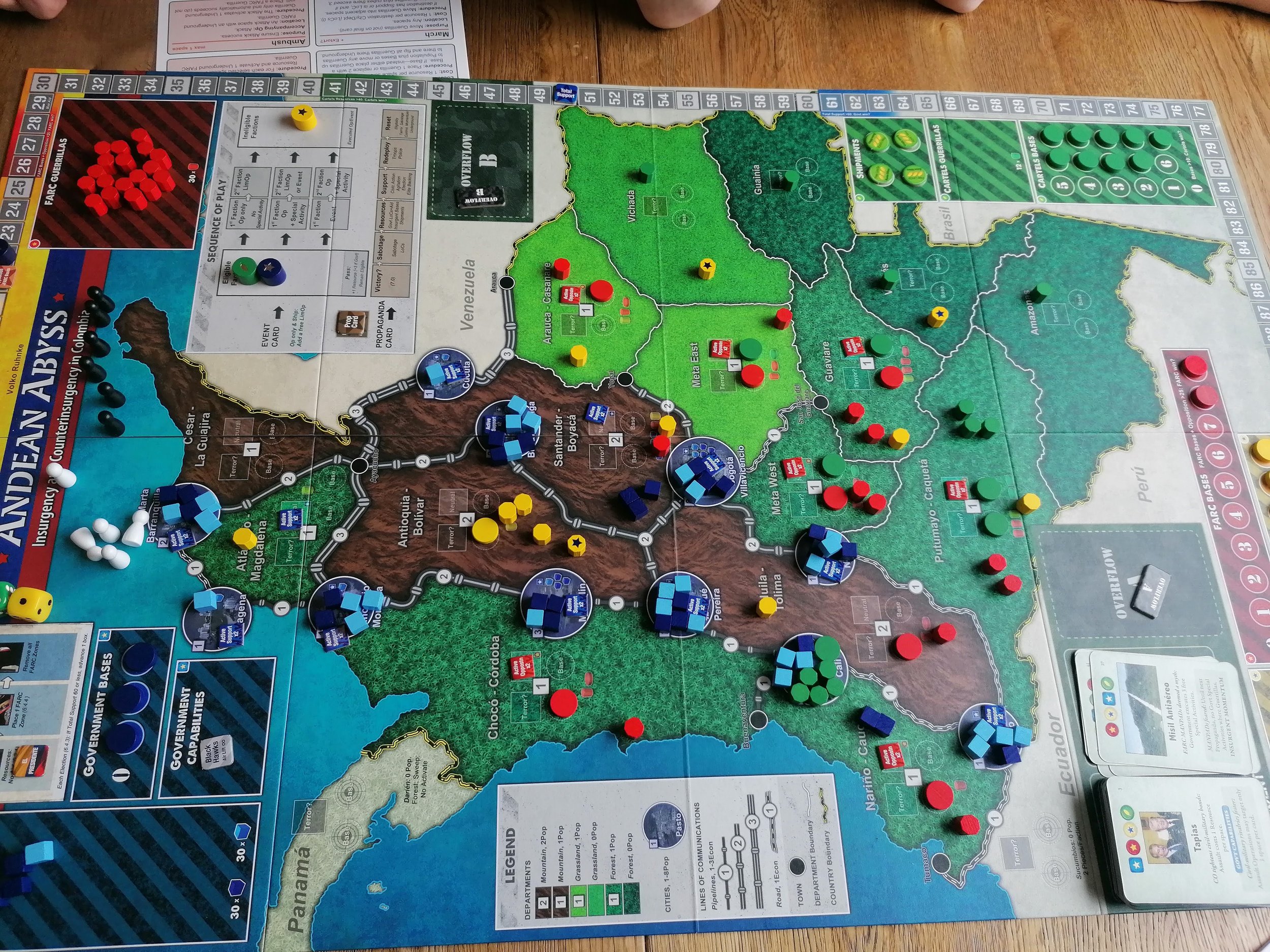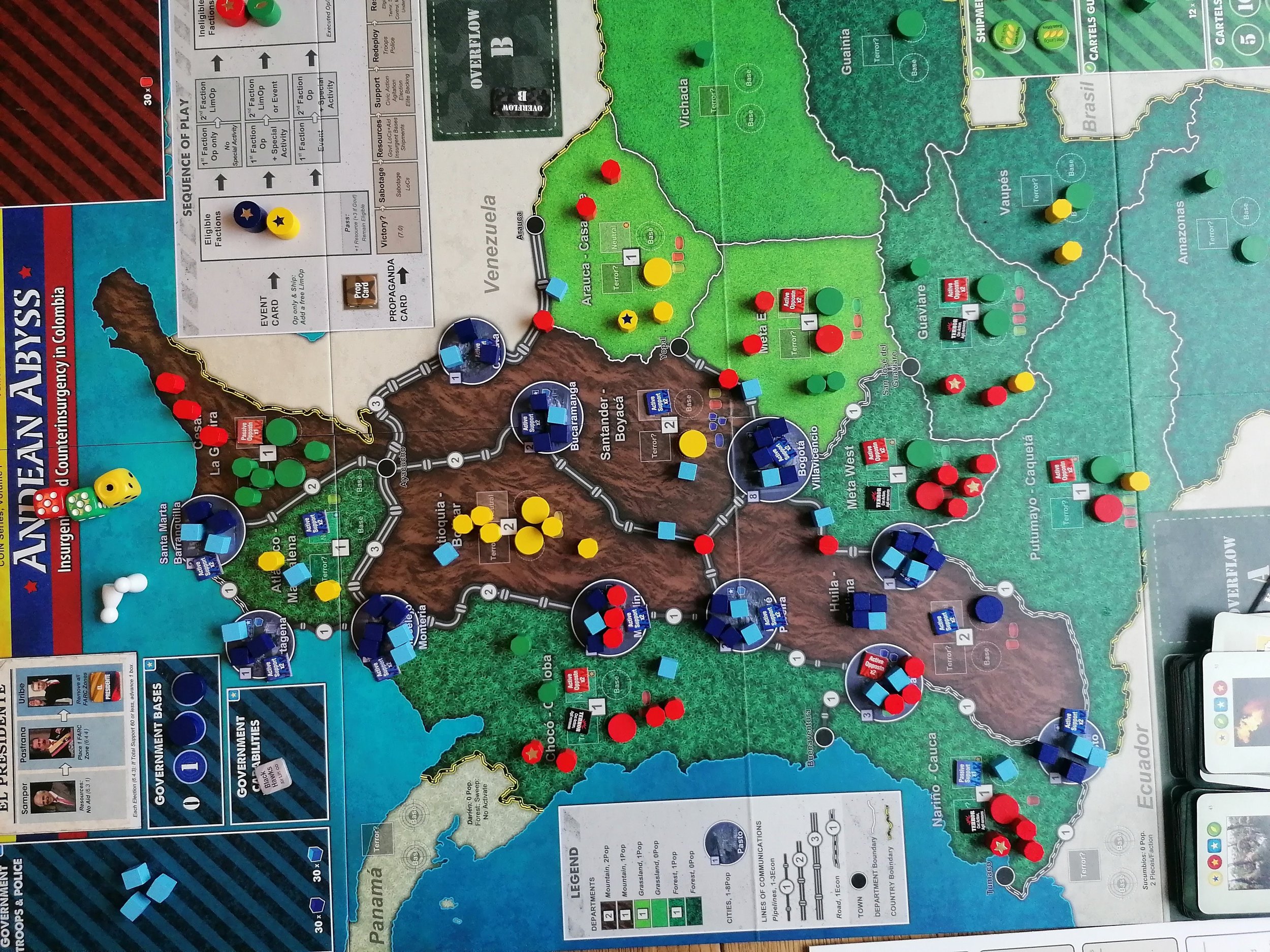I managed to get Andean Abyss to the table less than a week after learning it, which must be a record for me – it definitely beats the years I owned Here I Stand before I finally played it. I bought it largely because while Pendragon has been fascinating to learn, there’s no way I can teach that game to four people who have never played a COIN game before. It took me days to learn it – and I’m still not even sure I totally get it! The internet wisdom around learning COIN is to start with Cuba Libre, but for whatever reason the Cuban revolution doesn’t really grab me, so I went with the original COIN instead – Andean Abyss and the Colombian drug war. After all, if it wasn’t possible for people to learn from the original game then there wouldn’t be a series, would there? I’ve already documented my learning process on this blog (www.stuartellisgorman.com/blog/learning-coin-andean-abyss) but what that didn’t cover was teaching and playing the game, which is what we’re here for!
A few turns into the game, I’m playing the government and there are insurgents everywhere! The Cartels destroyed my only base, the jerks! The FARC action cylinder has been briefly stolen by a passing toddler (it was recovered and no one was harmed)
Teaching Andean Abyss was actually relatively straightforward. It helped that the three friends I was playing with are all long-term gamers with a lot of experience of board game systems. We’ve even played Root several times before, so asymmetric wargame is at least a little familiar even if COIN brings a lot that’s different to the table. I also simplified things for myself by playing the Government. For those who don’t know, in Andean Abyss the three insurgent factions (Cartel, FARC, and AUC) all share the same main actions with only some minor differences, and some of the factions also share special actions. This means that when teaching the game, I only really needed to go into detail on one set of main actions, and then run through the differences after. The Government plays very differently, so I gave everyone a rundown of what I could do and how I did it but didn’t need to go into quite the same level of detail.
The first Propaganda Card was at the bottom of the first stack, making me begin to worry I’d forgot to put one in! I was so distracted by it finally arriving that this picture is actually from a couple of turns later. Government successfully kept all the LOCs safe, but then spent all my funds on Civic Actions and spent this round desperately poor.
The other reason I chose the Government is that the Government in Andean Abyss is crazy hard to play competently – and I was definitely not going to be playing very competently. When teaching your friends, a complicated 3+ hour wargame, always choose the faction that is going to have the worst time. Don’t make your friends suffer so you can feel cool by winning a game you brought. I certainly did not do that. I didn’t do terribly – at final scoring I lost by one point – but it was tight for the whole game, and I was never that threatening. I basically just holed up in my cities making infrequent excursions into the country and airstriking isolated insurgent bases (usually the AUC when they got too big for their britches). My score rarely shifted – either up or down – and instead the main action was the three insurgent groups causing absolute chaos in the country while I periodically intervened and complained about how many resources it cost me to do so.
Soon after the second Propaganda Card - I messed up and let the Farc get support in Cali and a foothold in Medellin, but things are going a little better in some of the rural regions adjacent to cities. Mostly I’m letting the AUC mess with the FARC and then airstriking their bases when they get too close to winning.
I was correct in my learning post where I mentioned that I thought the Government would be a lot more interesting with real humans causing chaos in my country than when it was just me doing everything. The time I messed up and let the FARC get a foothold in Cali had me panicking. I was pulling my hair out every time I realised it would take me two actions to deal with a problem, or when I kept running out of money each round. It was very stressful, but on the very rare occasions when I successfully executed one of my plans to even pretty good results, I felt such satisfaction. Borderline incompetence has never felt so good.
We played for three Propaganda cards instead of the standard four because I didn’t want us to be playing for too long, particularly as we were just learning and there’s always the worry that someone will have a terrible start and suffer through several hours of gaming with little joy to be found. I didn’t really need to have worried about this latter situation too much, it turns out. Andean Abyss always leaves open the option for you to claw back some territory and there’s basically always something for any given player to do. It also really discourages ganging up on an already weak player, as that will just exhaust your resources for little real gain. You really don’t want to waste your limited resources and even more limited actions kicking a player while they’re down. This also lets them recover and come back swinging in a few turns once you’ve punished whoever the new leader is (or been punished if it was you!)
Approximately halfway through our third and final phase - I’m close to victory but unlikely to be able to afford to make the final push to reaching my victory objective. Meanwhile the insurgent players have discovered that they can fight each other and have descended into violent chaos.
I will admit that we got some rules wrong – I didn’t realise you could just keep Terrorising a region and adding piles of Terror markers there, which made things a bit harder for the insurgents – especially FARC (not that I exploited that to great success). Looking back there were also some errors around effects happening in regions where they maybe weren’t supposed to (i.e. something that should be in LOCs also including a city) but nothing that had a game changing impact on the result. It’s not that Andean Abyss is particularly complicated or fiddly, but there is a lot of information to keep in your brain and it’s easy to miss something when it’s everyone’s first time playing. Such is board gaming really – I’ll do better next time.
I don’t think it’s a shocking revelation that Andean Abyss is a great entry point to COIN – it’s literally the first game – but it is probably worth repeating no matter how many have said it before. I’m glad I chose Andean Abyss as the first COIN I convinced my friends to play with me. They all seemed to have a good time, even if I’m probably more eager to play it a second time than they are. They should at least tolerate me dragging along another COIN to play with them in the future – as long as it's not to the very next get together! We may all need a little breather.
The end state of the game after resolving the final Propaganda Card - nobody won outright but the Cartel secured a victory on the final check, with Government coming second, AUC third, and FARC last.
Andean Abyss is a fascinating piece of game design, and I could spend pages singing its praises, but I don’t think there would be very much point in that. The fact that there are fourteen games and counting in the series that it started is greater testament to Andean Abyss’s design than any small-time blogger could give. If you have a chance to play it, you absolutely should.





